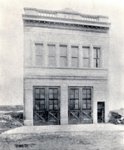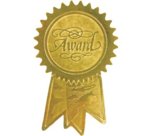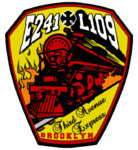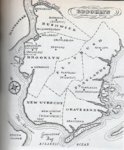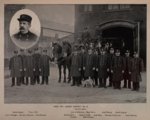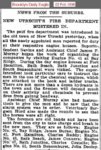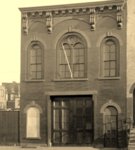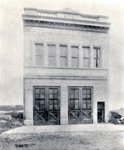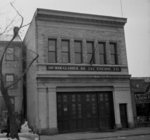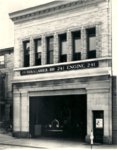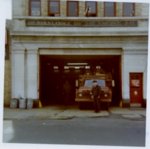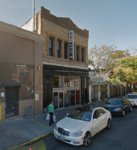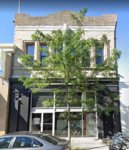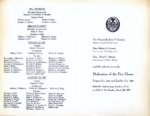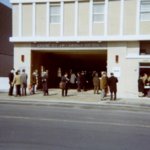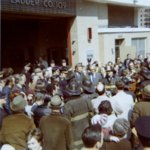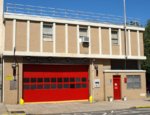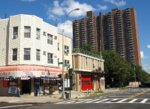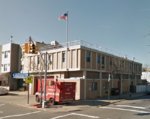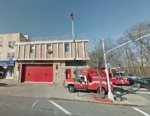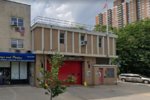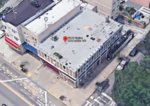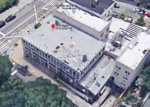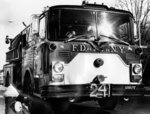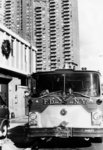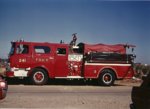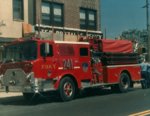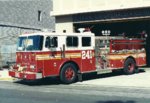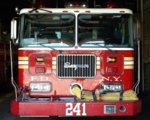Engine 241/Ladder 109 (continued):
BAY RIDGE AND ENGINE 241, 100 YEARS OF SERVICE
NYFD HOMEPAGE by: Mike Boucher Dispatcher 350 S.I. CO.
Bay Ridge, along with what would become the town of New Utrecht was bought from the Nyack Indians in 1647. Because of the color of the clay, Bay Ridge was first called Yellow Hook and then changed its name to Bay Ridge in 1853. Bay Ridge was a village in the town of New Utrecht, which was one of the six towns to make up the City of Brooklyn. The City of Brooklyn annexed the town of New Utrecht on May 3, 1894 along with the towns of Gravesend, Flatbush and Flatlands.
Fire protection in New Utrecht's dates back to 1827. Bay Ridge had three volunteer fire companies when the City of Brooklyn annexed the area. Bay Ridge Engine 1 was placed in service in a one story wood frame building on Bay Ridge Avenue near Third Avenue. In the rear was a bell tower to sound the alarms for a fire. Neptune Engine 2 was located on Sixty Seventh Street near Third Avenue. It was also a one story wood frame shed. Bay Ridge Ladder location remains a mystery to this day. It might have been located in with Engine 1 on Bay Ridge Avenue. New Utrecht volunteer fire department had grown to four steam fire engines, one hose company and five ladder companies.
The City of Brooklyn would provide fire protection into the newly annexed area once firehouses were built, equipment bought and manpower hired. Until this was done, the City was responsible for keeping the volunteers active. The volunteers would respond to fires and receive $1000.00 a year for their service from the City of Brooklyn until being replaced. The last fire the Bay Ridge volunteers attended was on Cowenhoven Lane and Stewart Avenue. The saloon and home of John Stoltz burned to the ground after a fierce early morning fire.
On February 1, 1896, the volunteer fire department of the late town of New Utrecht was replaced with a paid department. Bay Ridge's first paid fire companies were Engine 41 and Ladder 13. Both companies were placed in service on the same day, along with Engines 42, 43, 47, 53, and Ladders 14, 15, 19, and 24, all in the former town of New Utrecht.
In the law annexing the new area, Brooklyn could hire forty-three members from New Utrecht's volunteer fire companies. The members picked for Engine 41 and Ladder 13 were John R. Hanson, J. H. Van Pelt, Harry Martin, Albert Lyons, Michael Johnston, James Hennessy, John R. McIntosh, Ruppert Werner, Fred Wardell, John Erickson, and Elmore H. Wardell. The Foreman and Assistant Foreman came from other Brooklyn fire companies.
A new firehouse was built for Engine 41 and Ladder 13 on Bay Ridge Avenue near Ridge Boulevard. The lot was bought from the heirs of Joseph A. Perry for $1,800.00 on March 27, 1895. The lot measured 30 feet in the front and 100 feet deep. A beautiful two story, two bay firehouse, measuring 27 feet by 87 feet was built by the Leonard Brothers for $14,792.00. On the first floor was room for the steam fire engine, hose wagon and ladder truck, in the rear were the stalls for six horses and hay bins. The second floor had offices for the foreman and assistant foreman, a bunkroom, sitting room and a bathroom
In all of the annual reports put out by Brooklyn since 1869 it is always mention that the fireman had the latest and most modern convinces for their comfort. In the 1896 report a new item was added to every firehouse in the City, ".... a water heater, which supplies hot water for bathtub and wash basins. This improvement was a great boon to the fireman, particularly upon returning from fires tired and covered with smoke and dust, to have the convenience of taking a refreshing bath, without the risk or danger of taking cold, which was the case in former years, when only cold water was obtainable".
The firemen of 1896 did not have to worry about "do I go to work today" or finding a mutual partner. The work chart for the Brooklyn Fire Department was simple, 24 hours a day, six days on and the seventh day off. Twice a day, a fireman could go home for a two-hour meal period. The paid was around $1,000.00 a year. Members were detailed to other companies to relieve for a day off or meal break. In
Manhattan, the work chart was ten days on and one day off.
One of Engine 41 and Ladder 13 first fire did not go well for them. On May 25, 1896, a fire was discovered in a shed on 67th Street and 3rd Avenue. The chemical tank of Ladder 13 was placed in service which had little effect on the fire. By this time, the fire had spread to the former quarters of Neptune Engine 2, next door of the fire building, before water could be found in a cistern. The second due engine hooked up to the closest hydrant at 59th Street and 3rd Avenue only to run short of hose and had to make a trip to back to the firehouse for more hose. The third due engine from Fort Hamilton arrived with a line of hose from Bay Ridge Avenue and these two hose lines put the fire out. A total of four buildings were burnt with a loss of $10,000.00.
The Cities of New York, Brooklyn, Long Island City, the Bronx, the western part of Queens county, and Staten Island merged into the five boroughs of New York on January 1, 1898. The Fire Departments of New York City, Brooklyn, and Long Island City merged on January 28, 1898, along with all the volunteer companies in the area. After twenty-three months in Brooklyn, Engine 41 and Ladder 13 became Engine 41 & Ladder 13 of the Brooklyn & Queens Fire
Division of the New York City Fire Department. On April 15, 1898, Ladder 13 was disbanded as a separate fire company and the ladder truck assigned to Engine 41 to make it a combination company of an engine, hose wagon, and ladder truck. All the members were assigned to the engine company.
To avoid the confusion of two Engine 41s, one in Brooklyn and the other in the Bronx, the companies in Brooklyn and Queens were renumber on October 1, 1899. Brooklyn Engine 41 became Engine 141. The ladder companies were given 50 to the number, thus Ladder 1 became Ladder 51. The companies were re-number again on January 1, 1913, Engine 141 became Engine 241.
Combination Engine 241 was disbanded along with five other Combination Companies on May 15, 1914 and reorganized as a single engine company. Three new motorized ladder truck companies were placed in service, replacing the five horse drawn units. Ladder 147 was placed between Engines 240, 248, and 250, Ladder 148 between Engine 247 and 250, and Ladder 149 between Engines 241, 242, & 247.
The fire horse would be given a high place in fire service history. They were treated better than the men. The department had an ambulance to take the horses to the horse hospital when hurt or sick. Some say that the horses could count the bells and knew which ones they responded on. After a fire on a cold snowy winters night the horses would come back to the firehouse and the firemen would dry the horses, feed them and brush them down, then the men would take a hot bath, change clothes and warm up. The up keep on the horse for one year was around $800.00 a year, a new motor operated apparatus cost $64.00 for fuel. Engine 241 lost its horses in 1922 when they received a new American LaFrance 700 gpm-pumping engine.
The need for a ladder company in Bay Ridge had been felt since the ladder truck was placed out of service in 1914. On February 1, 1939 Ladder 109 was moved from 4th Avenue and 19th Street to Engine 241's quarters. The City of Brooklyn had put Ladder 109 in service, as Ladder 9, on August 20, 1891 in the former quarters of Engine 1, 4th Avenue and 19th Street, with Engine 1 was moved further south.
The firehouse on Bay Ridge Avenue was starting to show its age by the mid 1960's. The house was altered in the 1920's by removing the two apparatus doors and replacing them with one door. A kitchen was placed on the first floor where the stalls and hay bins had been. With Ladder 109 in quarters, the living conditions were cramped. A new two story, single bay, house was built on 3rd Avenue between Wakeman Place and 67th Street. The back corner of this new house would be touching the back corner of Neptune Engine 2's quarters if it were still standing today. The new house opened on March 22, 1971 with an address of 6630 3rd Avenue.
Lieutenant William P. Berry of Engine 241 received the Emily Trevor - Mary B. Warren Medal for rescuing Richard Pugh from a basement fire at 7123 4th Avenue on February 14, 1927. A lighted match or cigarette was thrown into a bucket of shellac, which exploded, trapping Pugh and his cousin Clarence E. Dennison, age 19 in the basement.
Lieutenant Berry and his crew pulled in front of the fire and was told of two men trapped in the basement. He crawled on his hands and knees until he found Pugh unconscious and carried him to safety. Dennison body was not found until the fire was out. Richard Pugh would later die at the Norwegian Hospital. Lieutenant Berry entered the burning basement without the backup of a hose line and at extreme personal risk, was awarded the Trevor & Warren Medal for 1927.
Fire fighting is the most dangerous job in New York City. Every year hundreds are injured while fighting the "Red Devil". Over the past 100 years many members of Engine 241 have injured, some to the point of not returning to work. Two members of Engine 241 have paid the supreme price with their lives.
Fireman Christopher Boines died has a result of a building collapse. The fire was discovered in the early morning of March 21, 1901. The large car barn, located at the foot of 65th Street belonged to the New York & Sea Beach Railroad Company. The building had been vacant for some three years and was in dilapidated condition. The men were ordered into the building and shortly afterwards the roof came down on them, trapping them. Fireman Boines and two members from Engine 201 and one from Engine 243 were taken to the Norwegian Hospital where Fireman Boines died several hours later of burns and broken bones.
Fireman Thomas Barragry died while fighting a fire in a freight car of the Long Island Railroad at 2nd Avenue and 65th Street on December 24, 1938. The fire was reported at 9:51 P.M. and Fireman Barragry collapsed and died at 10:05 P.M. from a heart attack cause by the overexertion. He was 51 years old and a member of the Fire Department since 1920. Fireman Barragry left a wife and three children.
Engine 241 has been serving the citizens of Bay Ridge since 1896. No matter what the call is, a fire, an EMS run, water leaks, explosions or just putting air in a child's bicycle, Engine 241, the 3rd Avenue Express, is ready, willing and able.
THE APPARATUS OF ENGINE 241:
HORSE DRAWN:
1895 LaFrance 4th size steamer #332
Feb. 1, 1896 - Nov. 29, 1922 1896 P. J. Barrett hose wagon #49B Feb. 1,
1896 - 1905 1905 C. N. Perkins hose wagon #100B
1905- Nov. 29, 1922 1896 Holloway 50' city service #1B
Feb. 1, 1896 - May 15, 1914 ladder truck with a 40 gallon chemical tank
MOTORIZED:
1922 American LaFrance 700 gpm #3955
June 25, 1938 1938 Ahrens Fox 1000 gpm #3440
April 8, 1958 1958 Mack 750 gpm #1028D
Dec. 10, 1971 1971 Mack 1000 gpm #MP7123
Feb. 9, 1981 1980 American LaFrance 1000 gpm #AP8010
April 10, 1986 1979 Mack 1000 gpm #MP7960
Dec. 30, 1992 1993 Seagrave 1000 gpm #SP9302
https://nyfd.com/brooklyn_engines/engine_241/engine_241.pdf
